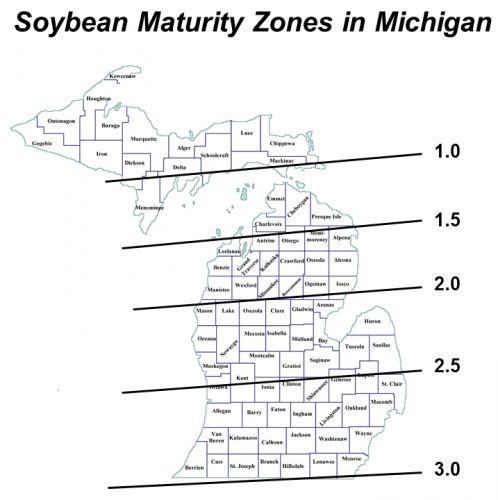Late-planted soybean recommendations
Soybean producers can use this information to help adjust their management practices and make informed decisions for late-planted soybeans.

Soybean planting has been delayed by the frequent rain events occurring this spring. As a result, many soybean fields will be planted in June and producers need to implement specific management practices to maximize the yield potential of late-planted soybeans. Michigan State University Extension recommendations for late-planted soybeans are summarized in this article.
Planting date
Plant as early as soil conditions permit. Yield losses due to delayed planting increase from 0.4 bushels per acre per day until June 1 to 1 bushel per acre per day on July 1. Also, remember that soybean maturity is delayed by one day for every three to four days that planting is delayed, increasing your risk of frost or freeze injury in the fall.
Marestail control
Producers must manage horseweed/marestail prior to planting as most of the populations in Michigan are resistant to glyphosate and many are also resistant to the ALS inhibitors.
Soybean variety maturity
Planting the correct maturity group is critical to maximizing soybean yields when planting in June. Most university trials have shown that adapted full-season varieties will yield better than early maturing varieties when planted in early June. This is because they produce a larger crop canopy before beginning to flower and have a longer timeframe to flower, set pods and fill seed. However, planting full-season varieties too late in the month increases the potential for frost or freeze damage to occur in the fall. Planting early-maturing varieties too soon will result in lower yield potential and short plants. The lowest pods on these short plants will be below the sickle bar and left in the field at harvest.
When planting before June 15, continue to plant varieties that align with the full-season maturity zones in Figure 1. When planting on or after June 15, plant varieties that are 0.5 to 1.0 maturity group earlier than the maturity zones shown in Figure 1.

Row spacing and planting rates
When planting in June, plant in narrow rows (15 inches or less) and increase planting rates. The combination of narrow rows and higher plant populations will help the crop canopy cover the soil sooner and capture more of the available sunlight. These conditions produce higher yields by increasing photosynthesis, pod height and weed suppression while reducing evaporation. Increase planting populations by 15 percent during the first half of June and by 20 percent when planting in the last half of June.
Seed treatments
Fungicide and insecticide seed treatments may be less beneficial with late planting as the soil will be warm and germination and emergence should occur rapidly – five to six days. If you are planting into a field with a history of Phytophthora root rot, plant a variety with specific race resistance or plant a variety possessing a high level of field tolerance and treat the seed with the highest recommended application rates of Mefenoxam, Metalaxyl, Ethaboxam or Oxathiapiprolin.
Planting depth
Whenever possible, plant soybean seed into at least 0.5 inches of uniform soil moisture. You may need to plant deeper to accomplish this when planting late. Soybeans should not be planted deeper than 2.5 inches.
Soybean aphid management
When aphids are deposited into soybean fields in the vegetative stages during mid-season flights, they will reproduce more rapidly and reach economic thresholds two weeks sooner than aphids deposited into fields in the early reproductive stages. Scout less mature fields often and thoroughly. Late-planted soybeans are also more susceptible to injury from aphid feeding as they will have less leaf area and root growth than soybeans planted earlier in the season.
Harvest and storage
Planting late increases the risk of freeze or frost damage occurring in this fall. Information regarding how to manage frost-damaged soybeans is available from MSU Extension.
Crop insurance decisions
Producers that have purchased a federal crop insurance policy may have prevented planting coverage. The “final planting date” for soybeans in Michigan is June 15. The “late planting period” is the 25 days following the final planting date. There is no prevented planting coverage for the Area Risk Protection Insurance (AYP/ARP) plans or the Margin Protection (MP). Make sure you understand the rules and ramifications of the following options:
- Soybean prevented planting acreage notices of loss must be submitted to your agent/insurance company within 72 hours after the final planting date or when the insured determines he/she will not be able to plant within the applicable late-planting period.
- Take the prevented planting payment after the final planting date has passed and leave the ground fallow or plant a cover crop that is not harvested prior to Nov. 1, 2019, and receive a full prevent plant payment .
- Plant soybeans after the final planting date, but before the end of the late planting period. The production guarantee or amount of insurance will be reduced by 1% for each day that planting is delayed past the final planting date.
- Take the reduced prevented planting payment on soybeans and plant another crop any time after the late planting period for soybeans has passed.
- Note that the prevented planting +10% option was removed from the 2018 crop insurance program, although the prevented planting +5% is still an option for producers.
This article was produced by the SMaRT project (Soybean Management and Research Technology). The SMaRT project was developed to help Michigan producers increase soybean yields and farm profitability. The SMaRT project is a partnership between MSU Extension and the Michigan Soybean Checkoff program.
MSU Extension offers additional educational resources and programs to help farmers as they deal with delayed planting seasons at https://www.canr.msu.edu/agriculture/delayed-planting-resources.



 Print
Print Email
Email